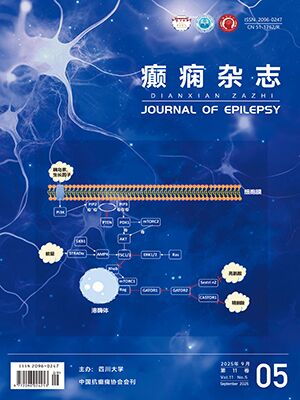| 1. |
D Bhalla, B Godet, M Druet-Cabanac, et al. Etiologies of epilepsy:a comprehensive review. Expert Rev Neurother, 2011, 11(5):861-876.
|
| 2. |
J Sellner, E Trinka. Seizures and epilepsy in herpes simplex virus encephalitis:current concepts and future directions of pathogenesis and management. J Neurol, 2012, 259(11):2019-2030.
|
| 3. |
YJ Chen, PC Fang, JC Chow. Clinical characteristics and prognostic factors of postencephalitic epilepsy in children. J Child Neurol, 2006, 21(5):1047-1051.
|
| 4. |
ME Lancman, HH Morris Ⅲ. Epilepsy after central nervous system infection:clinical characteristics and outcome after epilepsy surgery. Epilepsy Research, 1996, 25(7):285-290.
|
| 5. |
E Trinka, F Dubeau, F Andermann, et al. Clinical findings, imaging characteristics and outcome in catastrophic postencephalitic epilepsy. Epileptic disord, 2000, 62(2):153-162.
|
| 6. |
P Kahane, C Barba, S Rheims, et al. The concept of temporal 'plus' epilepsy. Revue Neurologique, 2015, 171(8):267-272.
|
| 7. |
C Barba, S Rheims, L Minotti, et al. Temporal plus epilepsy is a major determinant of temporal lobe surgery failures. Brain, 2016, 139(9):444-451.
|
| 8. |
郭强, 朱丹, 张玮, 等.立体脑电图在药物难治性癫痫患者术前评估中的应用.中华神经外科杂志, 2016, 32(3):261-265.
|
| 9. |
P Kahane, E Landré, L Minotti, et al. The Bancaud and Talairach view on the epileptogenic zone:a working hypothesis. Epileptic Disord, 2006, 8 (Suppl. 2):16-26.
|
| 10. |
张绍辉, 张军臣, 胡晓红, 等.单侧前颞叶切除治疗偏侧癫痫发作起源优势的双侧颞叶癫痫.癫痫杂志, 2015, 1(1):43-47.
|
| 11. |
P Kahane, F Bartolomei. Temporal lobe epilepsy and hippocampal sclerosis:lessons from depth EEG recordings. Epilepsia, 2010, 51(Suppl. 1):59-62.
|
| 12. |
E Trinka, F Dubeau, F Andermann, et al. Successful epilepsy surgery in catastrophic postencephalitic epilepsy. Neurology, 2000, 54(10):2170-2173.
|
| 13. |
C Barba, G Barbati, L Minotti, et al. Ictal clinical and scalp-EEG findings differentiating temporal lobe epilepsies from temporal 'plus' epilepsies. Brain, 2007, 130(11):1957-1967.
|
| 14. |
H Liiders, J Acharya, C Baumgartner, et al. Semiological Seizure Classification. Epilepsia, 1998, 39(10):1006-1013.
|
| 15. |
E Guedj, F Bonini, M Gavaret, et al. 18FDG-PET in different subtypes of temporal lobe epilepsy:SEEG validation and predictive value. Epilepsia, 2015, 56(8):414-421.
|
| 16. |
AF Struck, LT Hall, JM Floberg, et al. Surgical decision making in temporal lobe epilepsy:A comparison of[18F] FDG-PET, MRI, and EEG. Epilepsy & Behavior, 2011, 22(7):293-297.
|
| 17. |
C Rathore, JC Dickson, R Teotónio, et al. The utility of 18F-fluorodeoxyglucose PET (FDG-PET) in epilepsy surgery. Epilepsy Research, 2014, 108(20):1306-1314.
|




